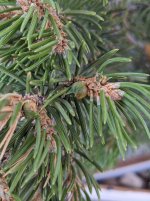JesseKane
Sapling
I collected this piñon the first week of September last year and have had some issues with needles dying. I couldn't match the symptoms with any of the local piñon pests so decided it was likely a result of collection stress. The native soil was typically very sandy and I wasn't able to get a strong rootball, so that seemed to fit. I kept the tree in a heat bed over winter in our unheated garage and the little guy seemed to do great with no more needles dying. I don't have any new growth yet, but that wasn't too surprising as I've heard piñons can be temperamental and may not show any new growth until their second growing season after collection. So everything was going reasonably well until about two weeks ago when I see the same needle symptoms suddenly pop back up. I thought I would ask all the piñon experts out there for their input on what may be going on! So here are some pictures and my list of current theories.
First, an overview of one of the areas effected. Note that this is occuring on many of the branch tips but not all of them. Seem to be mostly on the needles that were on the underside of the branch in its native location. The browning starts at the base of the needle and proceeds up to the tip.


First clue: Many of the needles have a tiny hole in them. It's usually on one of the two in a pair, with that damaged needle being the first to die. The second follows a few days later. The pic below shows a dead needle in a pair with a hole, with a fresh needle next to it showing the same damage.

While taking pictures tonight I did notice this lil bug flying around the needles. Unsure if it's just a gnat or if it may be a male scale insect. Including here just in case.

This spring I found a few what I'm pretty sure are Spindlegall midge that were present at collection. I removed all the effected needles before the larva emerged but I'm including here for completeness.


Tonight I found what I assume to be some eggs on one of the needles. This is the first and only needle that I've found with this particular symtpom. The needle was far away from the other clustered areas showing needle death, so I'm leaning towards this being unrelated to the larger issue.

My current theories:
First, an overview of one of the areas effected. Note that this is occuring on many of the branch tips but not all of them. Seem to be mostly on the needles that were on the underside of the branch in its native location. The browning starts at the base of the needle and proceeds up to the tip.


First clue: Many of the needles have a tiny hole in them. It's usually on one of the two in a pair, with that damaged needle being the first to die. The second follows a few days later. The pic below shows a dead needle in a pair with a hole, with a fresh needle next to it showing the same damage.

While taking pictures tonight I did notice this lil bug flying around the needles. Unsure if it's just a gnat or if it may be a male scale insect. Including here just in case.

This spring I found a few what I'm pretty sure are Spindlegall midge that were present at collection. I removed all the effected needles before the larva emerged but I'm including here for completeness.


Tonight I found what I assume to be some eggs on one of the needles. This is the first and only needle that I've found with this particular symtpom. The needle was far away from the other clustered areas showing needle death, so I'm leaning towards this being unrelated to the larger issue.

My current theories:
- Needle Scale. I don't see any symptoms other than a hole in the needle. Newest needles are effected unlike what scale targets. Seems unlikely
- The holes may be red herrings and leftover damage from spindlegall midge. I haven't been able to see any insect activity, which is a key symptons of diagnosis it seems, so I doubt there are active midges. That may point to the next two causes that are unrelated to pests
- Sun stress. I potted the tree in a different orientation than what it was in on the mountain, about a 90deg rotation up. The under sides of the branches are now exposed to some sun. This was my original theory
- Tree recovering from the stress of collection by shedding branches. Makes sense as this newest round started around the time when conifers start transitioning into vascular growth. The roots are still weak, but I dug around in the pumice a bit and was able to find a coule fresh growing tips. This was in early June this year.
